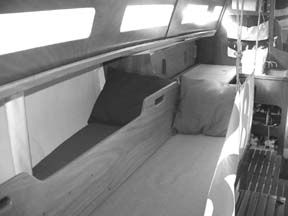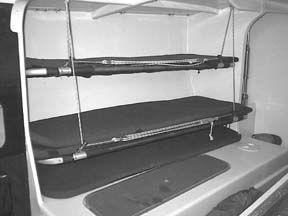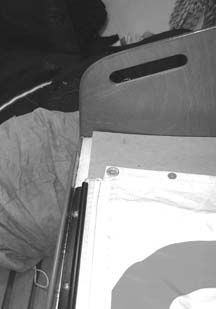
Whether you’re crossing the Gulf Stream to Bermuda or the Bahamas, racing to Halifax or Hawaii, or just cruising coastal waters, having proper sea-berths for the off-watch crew is an often neglected, yet vitally important element of a good offshore boat. Why are good seaberths a shipboard necessity? Anytime a vessel is underway for more than a few hours, a rested skipper and crew are essential for the safe operation of the boat.
Even in this day of sophisticated electronic navigation, boats are occasionally lost while entering an unfamiliar port at night or in foul weather. Often a major factor contributing to dire mishaps like these is the lack of seaberths on board, which can lead to an exhausted and mistake-prone crew that’s yearning to get ashore as soon as possible. A well-designed seaberth not only ensures comfort for its occupant during time afloat, but also provides the security necessary to minimize the possibility of injury from being launched across the cabin in the case of a knockdown, broach, or other drastic change in course.
We are beyond the age of Lord Nelson’s navy when hundreds of sailors aboard a man-of-war slept in hammocks slung a regulation 18″ apart. For generations of sailors, hammocks were the seaberth of choice. These simple devices maximized space, stayed comfortably level as Jack Tar gently swung to the roll of the ship, were easy to enter and exit, and did double duty when stacked as protection against incoming cannon balls.
These days, unless you’re single or double-handing, in which case one seaberth may be sufficient, half the number of crew, plus one, is the minimum number of proper seaberths PS recommends.
An extra seaberth allows non-watchstanding guests or seasick crew to be comfortable, yet out of harm’s way while the boat is being worked. If unoccupied, an extra seaberth provides secure stowage for duffles, laptops, or other sensitive items. To prevent frustration and seasickness, sea-berths should be assigned, located, and prepared in advance of setting sail, especially at night or during heavy weather when a tired crew just wants to undress and fall into a welcoming bunk, rather than face the chore of emptying and making up the berth.
What makes a proper seaberth? Despite a broker’s alluring words or a glossy advertisement featuring flowers and hors d’oeuvres in a seductive interior, a seaberth is not just a salty name for a bunk cushion secured by fiddles. Location, dimensions, and detailing all are important elements as a functional seaberth is more than the sum of its parts. Size, shape, lighting, ventilation, noise, cushions, ease of access, lee cloth/bunkboard functionality, view of navigational instruments, even the quantity of pillows are the more important considerations when designing and fitting a seaberth.
Location, Location, Location
The best location for seaberths can be a lively topic of discussion. Generally, a good seaberth is situated aft of the mast, where the pitching motion is least. Although a forward cabin may occasionally be an excellent place to sleep, particularly while motoring in flat water or sailing downwind in consistent breezes, a forward cabin is not a good location for a seaberth due to the increased motion underway, the noise of waves drumming against the flat panels of the bow, the triangular shape of the V-berth, and the difficulty of providing leak-free ventilation.
Because the motion of a boat is less appreciable lower in the hull, a good cruising seaberth is best located lower, rather than higher in the interior. Although rarely acceptable on a racing boat, sleeping on the leeward side provides an excellent compromise of reduced pitch, roll, and noise, as a leeward bunk is low in the boat and gravity becomes an ally to assist in keeping one securely in the bunk.
Additionally, the lullaby of water swishing along the lee rail can sooth one to sleep. In an emergency, a comfortable temporary seaberth can often be improvised by laying a bunk cushion on the cabin sole (the lowest habitable location on most boats,) and using sail bags and duffles as cushioning.
Ideally, a seaberth should be located parallel to the centerline of the boat. If not, as the boat heels, the bunk’s lengthwise axis will change from horizontal. In such a case, the more the boat heels, the less effective the bunk becomes, as sleeping with your feet higher than your head, (or vice versa), may cause vertigo or other unpleasant effects. Even a few inches of bunk asymmetry relative to the centerline can make a big difference. This rules out the use of athwartships (crosswise) berths as a seaberth while underway.
A proper seaberth is at least 76″ in length, 22″ to 28″ wide along its entire length, and a minimum of 24″ from the top of the bunk cushion to the overhead. Seaberths of these approximate dimensions provide a snug fit for security, yet allow enough volume for pillows, blankets, clothing, and the taller or wider-bodied crewmember. Any narrower or shallower, and the seaberth begins to assume the ambiance of a coffin with the comfort of a torpedo tube. Any wider, and the occupant can roll uncomfortably from side to side as the boat rolls, pitches, or yaws. Extra wide or double berths can effectively be converted into two seaberths using lee cloths and/or removable bunk boards.
Except for the proximity to the engine room, the time tested aft “quarter berth,” as found on a Cal 40 and many other mature designs, is often the quintessential seaberth. Even more modern designs such as the Catalina 42 can benefit from retrofitted seaberths.

Another excellent seaberth is a main cabin settee. With a large number of crew, settees sometimes suffer from traffic and disruption due to cabin lights, galley and nav station noise, and sunlight from the cabin ports and hatches. But with the use of lee cloths, window and hatch curtains, eye shades, and foam ear plugs, most such disruption can be minimized for those sailors using a settee as a seaberth.
The easiest to install, and perhaps the most comfortable seaberth is the pipe berth. Pipe berths have been around for generations, and remain the seaberth of choice on race boats where windward side crew weight is paramount.
Pipe berths are usually rectangular aluminum or carbon fiber tubular frames that are hinged to the hull, and are lightweight, strong, and can be racked two, or even three high. Even a frame constructed of PVC plumbing pipe, or a hinged plywood board with a cushion can make an inexpensive yet comfortable pipe berth.
Pipe berths offer the advantage of being easily retrofitted in many areas aboard even the smallest boats. Lowered to a near vertical position, a pipe berth can also double as a back rest for a lower bunk or settee. Surprisingly, the biggest advantage of pipe berths is their comfort, as they can be lowered for access, then leveled for sleeping using the 4:1 purchase system.
Another excellent seaberth is the pilot berth, located above and outboard of settees on some boats. In fact, the best seaberth on a boat like the Santa Cruz 50 or 52 is the main cabin pilot berth, as it is out of the way of traffic and noise.
But on many designs, the pilot berth is not an option, as this space is dedicated to book shelves, entertainment consoles, and even water ballasting tanks. Unless well designed and constructed early on, pilot berths are often too narrow, uncomfortably shaped, or compromised by the boat’s frames, stringers, chain plates, or other hull structures.
For shorthanded sailing, a “wet berth” is a vital asset to boathandling and safety. A wet berth is a secure rest area protected from inclement weather where the skipper or watch stander can rest (often in foulies), immediately available to lookout, steer, trim, or perform other boat handling responsibilities. A wet berth might be a cushion placed on the floor of the cockpit, in the lee of a dodger, or below in a pilot house where the navigation instruments are readily visible. Ideally, a wet berth is below out of the elements, adjacent to the companionway, with a good view of the compass, radar, depth sounder, and chart plotter, and with the autopilot and auxiliary engine controls also readily at hand.
Lee Cloths
Every good seaberth will benefit from fine-tuning to provide comfort. Except for pipe berths, a rectangular lee cloth is the primary means of securing an occupant in a seaberth. Although a satisfactory lee cloth can be made from old sail cloth, the best lee cloths are sewn using breathable acrylic canvas such as Sunbrella™.
Where possible, lee cloths should extend along the full length of the bunk and be secured in a vertical plane, or angled slightly inward toward the sleeper. Unfortunately, commercially available lee cloths, such as those available at West Marine, are too short (45″) to restrain both head and feet from hanging out of the seaberth. In addition, many commercially available lee cloths are made of less than substantial vinyl plastic mesh, which may give an unpleasant feeling to bare skin and rip at inopportune moments. Consequently, most good lee cloths are custom-made.
As noted, a lee cloth should be as long as possible, and rise at least 12″ above the top of the bunk cushion. The bottom edge of the lee cloth can be secured with either a batten and screws, or through bolted at 6″ centers to the bunk top. An even better method of securing a lee cloth is a bolt rope that is sewn to the bottom edge of the cloth and then inserted in a bolt-rope track, (plastic or aluminum, available from most canvas makers), which is screwed to the bunk top. This allows for easy removal of the lee cloth for washing.
If the bunk cushion is double wide and lee cloth placement is difficult, bunk boards can also be used in lieu of lee cloths. In the situation where neither a bunk board nor a lee cloth is an option, a low-stretch line can be inserted and sewn along the bottom edge of the lee cloth, and tautly secured to points at the head and foot of the bunk cushion, so that the bottom of the lee cloth rests along the top of the bunk cushion. When not in use, lee cloths can be laid flat and tucked out of the way under the bunk cushion.
Lee cloths are often subjected to considerable abuse and side force, so the top edge and corners of the lee cloth need reinforcing. The grommets on the upper corners should be laced taut with 1/4″ line on an upward-sloping 45-degree angle to securely anchored padeyes or the equivalent. And the two mid grommets need to be tensioned vertically to overhead padeyes. Even better, they can be run over an overhead handrail. The handrail will also assist the berth occupant in recovering from the horizontal position.
Tensioning lee cloth lines is usually a haphazard affair. The best adjustable knot is the rolling hitch, which can be slid along the support line to achieve proper tension. A better solution is a friction plate that can be fashioned from a simple 2″ x 4″ x 3/16″ rectangle of wood, or a dowel, with two holes drilled into it that provide an easily adjusted purchase.
Seaberth Accessories
Next to location and lee cloths, ventilation is the most important consideration for a good seaberth. Unfortunately, ventilation from nearby opening ports often admits water as well as air. An excellent alternative is the use of an electric fan. PS recommends that sea berths be ventilated with a fan mounted at the head of the bunk where possible. Such a fan should be quiet, adjustable, miserly on power consumption, and produce no radio interference.

Lighting for a seaberth is available in many options. One good option that helps maintain night vision is the use of a red-white combination light. Even having a battery powered headlamp available in each seaberth is sufficient.
Another aid for a good seaberth is the use of foam earplugs. While they may not be for everyone, they can dampen annoying sounds and muffle engine and radio noise to an acceptable level. Of course a skipper or navigator must always sleep with one ear open, and leading a “signal line” from the seaberth to the helm can facilitate this awareness. This is particularly useful when sailing shorthanded, or with inexperienced crew.
As experienced distance racers know, when possible, crew should sleep in seaberths with their feet forward. This practice lessens the chance of head or neck injury in the event of unanticipated rapid deceleration, as in the case of a collision with a whale, or when being tossed about by larger than average waves. If venturing into areas of potentially rugged upwind conditions such as the Baja Bash, crossing Hawaiian Island channels, or the Windward Passage, it is also recommended to consider installing seat belts across each seaberth as a measure to prevent airborne crew.
Such a measure would have been appreciated earlier this winter when a crewmember aboard one of the boats competing in the Global Challenge suffered a dislocated hip and bone fragmentation after he was thrown from his berth when the boat became airborne following a hit by a particularly large wave while en route from Australia to South Africa.
Safety is paramount in this event, and the 72-foot vessels competing have purposely designed seaberths for all off-watch crew. Granted, relatively few of us will ever voyage through this patch of ocean aboard our boats, but the point is clear—offshore and ocean sailing vessels should have good, properly equipped seaberths. And given the growing popularity of cruiser-friendly rallies and races—the ARC, the Caribbean 1500, the Newport-Ensenada Race, and the Baja Ha-ha among them—having a sufficient number of properly equipped seaberths on board shouldn’t be regarded as optional.
Also With This Article
“Where are the Seaberths?”


































Really REALLY good article; and I am relieved as well as amused to discover that the saloon berths in my own little cruising boat fit all of Darrell’s specifications to a tee. Thanks for the enlightenment and confirmation!